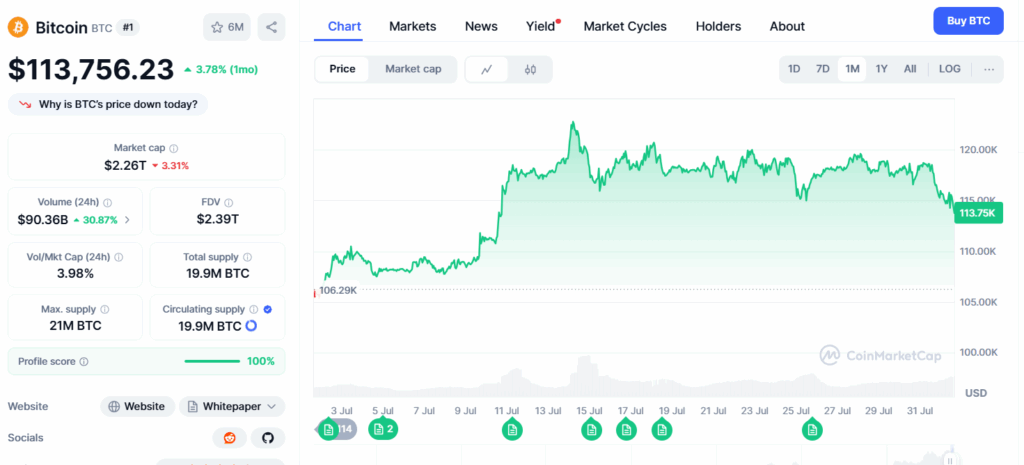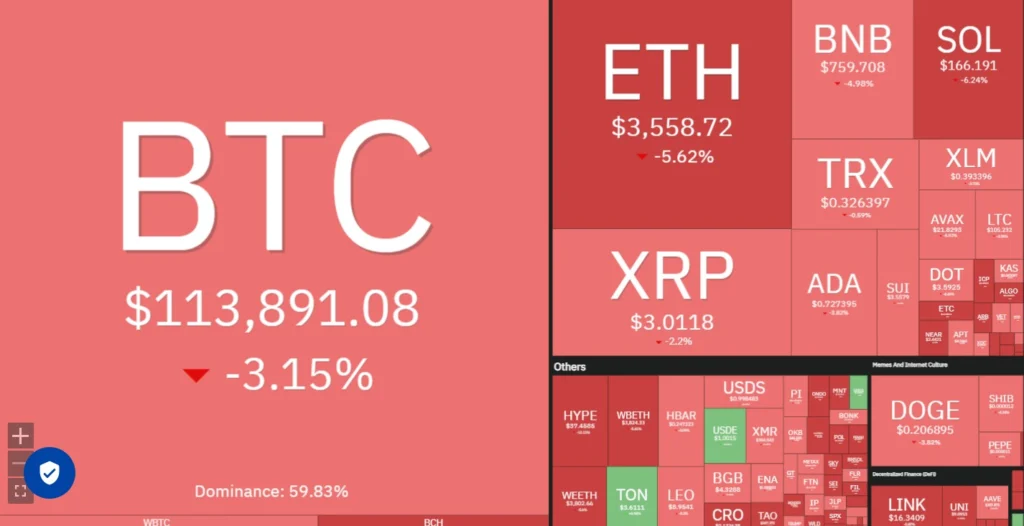
July brought major movements across the crypto market.
SEC Chairman Paul Atkins publicly reaffirmed the right to self-custody of crypto assets, while Ethereum stood out with strong gains — even outperforming Bitcoin, which still reached a new all-time high.
Additionally, ETFs, U.S. regulatory developments, and growing institutional adoption were key factors shaping the market landscape.
We also saw a rebound in the NFT market, altcoins posting impressive gains, record-breaking profits from companies like Tether, and a worrying spike in attacks targeting protocols and exchanges.
In this article, we break down the top highlights that shaped the market in July — and what to watch for in the months ahead.
Paul Atkins Reaffirms Right to Self-Custody in New SEC Initiative

Source: X
During the launch week of Project Crypto, SEC Chairman Paul Atkins reaffirmed his commitment to financial freedom for crypto users. The statement was made on July 31, 2025, during the project’s official announcement.
“I strongly believe in the right to use a non-custodial digital wallet to hold personal crypto assets and participate in on-chain activities like staking.” — Paul Atkins
Legal Backing for Crypto Self-Custody
Atkins emphasized that self-custody is a fundamental right, especially in a financial system that aims to be more decentralized and inclusive. According to the SEC Chairman:
- Users should have full control over their private keys
- Using a non-custodial wallet should not be regulated as brokerage or financial intermediation
- Staking via self-custody does not constitute a securities offering
This perspective is now part of the SEC’s new regulatory framework introduced this week.
What Is Project Crypto?
Launched on July 31, 2025, Project Crypto is the SEC’s new initiative to:
- Provide clearer guidelines for digital tokens and DeFi
- Legally protect the use of self-custodial wallets
- Prevent wallet developers from being classified as financial agents
- Encourage innovation without compromising investor safety
Why This Matters
- Crypto Self-Custody: Now has institutional and legal support in the U.S., reinforcing users’ rights to maintain full control of their assets
- Staking with Personal Wallets: Legally protected when done without intermediaries, ensuring regulatory clarity for PoS network participants
- Non-Custodial Wallet Developers: Face fewer legal risks when offering tools that preserve user sovereignty
- Crypto Users: Gain greater clarity, confidence, and protection to interact with the crypto ecosystem safely and independently
This marks a new regulatory era that strengthens the position of users, developers, and companies building decentralized solutions.
Crypto Market Performance – July 2025

Source: Cointelegraph
July saw a significant surge in digital asset prices. Ethereum (ETH) jumped approximately 54%, outperforming Bitcoin (BTC), which rose around 10% during the same period
Why Did Ethereum Outperform Bitcoin?
Approval of the GENIUS Act
- The new U.S. regulatory framework brought legal clarity to stablecoins, encouraging their issuance on Ethereum.
- Investors viewed Ethereum as the most suitable network for hosting regulated stablecoins.
Record Inflows into Ethereum ETFs
- Institutional ETH ETFs from firms like BlackRock, Fidelity, and Grayscale attracted over $123 billion in global inflows in July.
- In the U.S. alone, ETH ETFs reached $21 billion in AUM, representing 4.6% of the token’s circulating supply.
Rising Corporate Adoption
- Companies like Bitmine and SharpLink announced they were adding Ethereum to their balance sheets, reinforcing institutional confidence in the asset.
Bitcoin Price – July 2025

Source: Coinmarketcap
In the final week of July, Bitcoin (BTC) fluctuated between $117,600 and $119,400, closing the month at approximately $115,700.
This slight pullback marked a technical pause following the all-time high reached earlier in the month.
All-Time High: Bitcoin Breaks Above $122K
On July 14, 2025, Bitcoin hit its highest price ever: $122,566, driven by:
- Approval of the GENIUS Act in the U.S.
- Record inflows into Bitcoin ETFs
- A more favorable regulatory environment for digital assets
Key Drivers Behind Bitcoin’s Rally
- Institutional Adoption Through ETFs
ETFs like the iShares Bitcoin Trust attracted over $38 billion in inflows this year, boosting liquidity and strengthening Bitcoin’s position in the market. - Billion-Dollar Sale With Minimal Impact
In July, Galaxy Digital sold 80,000 BTC (~$9 billion). The market reaction was surprisingly mild — just a 1% dip — highlighting Bitcoin’s maturity and resilience as a financial asset. - Regulated Environment Increases Confidence
With the approval of the GENIUS Act and Clarity Act, Bitcoin is now seen as having greater legal clarity. This has reinforced its status as a store of value, comparable to digital gold.
NFT Market Gains Momentum
Global NFT sales reached $574 million in July — a 47.6% jump compared to June.
Ethereum-based NFTs accounted for $275.6 million, making up nearly 50% of total volume.
Fewer transactions, but higher value per sale: the average sale price rose to $113.08 — the highest in six months — suggesting growing consolidation by large investors (whales).
Top Collections:
- CryptoPunks led in volume with $69.2M.
- Pudgy Penguins saw its floor price surge by 65.4%, generating over $55.5M.
Altcoins on the Rise: July Highlights
Several altcoins posted impressive gains in July:
| Token | Change (%) | Key Drivers |
| PENGU (Pudgy Penguins) | +290% | Token launch on Abstract Network (Solana) |
| CFX (Conflux) | +170% | Expansion in the Asian market and new business partners |
| BONK | +158% | Social media hype, high trading volume, and token burns |
These gains were fueled by strong community engagement, strategic listings, and ecosystem innovations.
Crypto Market Today – August 1

Source: Coin360
Leverage liquidations and macroeconomic uncertainty drag crypto prices down
Bitcoin drops 2.8%, falls to $115K on Friday
On the morning of August 1, 2025, Bitcoin (BTC) deepened its recent losses, dropping to $115,105 — its lowest level in weeks.
XRP and Solana lead altcoin losses
Altcoins saw even sharper declines:
- XRP: down 7.1%, trading at $2.94
- Solana (SOL): down 7%, now $168
- Ethereum (ETH): down 6%, trading at $5,932
- BNB: down 4.8%, at $706
Almost every cryptocurrency in the top 100 posted losses — except Provenance (HASH), which edged up 0.4%.
Why the drop? Liquidations and risk-off sentiment
Analysts point to two main causes for the decline:
- Over $750 million in leveraged positions were liquidated in the past 24 hours
- A shaky macroeconomic backdrop, with a stronger U.S. dollar, trade tensions, and uncertainty over U.S. interest rates
These factors triggered broader risk aversion and increased selling pressure across the crypto market.
Context: Market taking profits after all-time highs
The pullback comes after Bitcoin hit an all-time high of $122,800 in July. Since then, miners and large holders have been taking profits, increasing supply and accelerating the downturn.
According to CryptoQuant, the market may be entering a more extended correction phase, with potential for further declines in the coming months.
Ethereum Raises Gas Limit by 25% to Speed Up Transactions

On July 30, 2025, the Ethereum network increased its per-block gas limit from 36 million to 45 million — a 25% boost. The change was implemented at block 22,968,004 after receiving approval from the majority of staking validators.
Why does this matter?
The gas limit determines how many transactions and smart contracts can fit in each block. With more computational space, the network can:
- Process more transactions per second (TPS)
- Reduce network congestion
- Lower average gas fees during peak demand
Notably, this upgrade did not require a hard fork — Ethereum’s protocol allows for automatic adjustments when over 50% of validators agree.
Part of a broader scalability roadmap
This increase is part of Ethereum’s plan to:
- Reach 60 million gas per block in the coming weeks
- Scale up to 150 million with future upgrades like EIP‑7732 (Fusaka)
- Prevent abuse with a per-transaction cap of 16.77 million gas (EIP‑7983)
Direct impact for users and dApps
Benefits:
- Faster transaction confirmations
- Lower ETH gas fees
- Better performance for dApps and decentralized exchanges
Risks:
- Increased resource demand for validator nodes
- Potential centralization risks
- Faster growth of the blockchain’s data size
What to expect going forward
This gas limit hike makes Ethereum more efficient — especially during periods of high activity — and better equipped to support more users and Web3 applications without compromising security.
It also enhances Ethereum’s competitiveness against high-throughput, low-cost chains like Solana and Avalanche.
Tether Reports Record Profit of R$27.3 Billion in Q2 2025

Source: cointelegraph
Tether, the issuer of the USDT stablecoin, posted a record net profit of $4.96 billion (around R$27.3 billion) in the second quarter of 2025.
The result exceeded all expectations and reinforces Tether’s dominance in the stablecoin market.
In total, profits for the first half of the year have already surpassed $5.7 billion (~R$31.8 billion), according to the company’s official report.
During Q2 2025, Tether issued $13.4 billion in USDT, bringing the total circulating supply to over $157 billion.
Since the beginning of the year, the supply has grown by $20 billion — fueled by increased demand for stablecoins in DeFi, exchanges, and cross-border payments.
Solid Reserves: $127 Billion in U.S. Treasuries
Tether stated that over 90% of its reserves are held in highly liquid assets, mostly U.S. Treasuries:
- $105.5 billion in direct holdings
- $21.3 billion in indirect exposure
These reserves back USDT’s 1:1 peg to the dollar, reinforcing institutional confidence in the asset.
How is Tether using its profits?
In addition to maintaining strong reserves, Tether is investing up to $4 billion in strategic sectors such as:
- Artificial intelligence and digital infrastructure
- Renewable energy
- Bitcoin mining (in partnership with Twenty One Capital)
- Content platforms like Rumble
These moves signal revenue diversification and a long-term strategy to reduce reliance solely on interest from public debt.
Why does this matter for the crypto market?
Positive impacts:
- High USDT liquidity for trading and DeFi protocols
- Reinforced stability and trust in the world’s most-used stablecoin
- Broader influence from Tether in blockchain infrastructure
Concerns to watch:
- Ongoing criticism over transparency and lack of independent audits
- Potential regulatory pressure in the U.S. and Europe
- Macroeconomic risks due to heavy reliance on sovereign assets
Q2 2025 confirms Tether’s absolute leadership in the global stablecoin market.
Rise in Crypto Attacks – July 2025

Source: Money Times
Crypto protocol and exchange breaches totaled $142 million in July 2025 — a 27.2% increase from June’s $111.6 million loss.
This spike highlights a growing trend of cyber threats in the digital asset space, with attackers increasingly targeting employees and hot wallets.
Major Crypto Hacks in July
1. CoinDCX: Malware & Social Engineering – $44.2M
The largest theft of the month hit Indian exchange CoinDCX, where an employee downloaded a fake job offer file containing malware.
- The malware gave hackers access to an internal hot wallet, enabling them to withdraw $44.2M across six external addresses.
- Customer funds in cold storage were not affected.
- The perpetrator has been arrested, and CoinDCX is offering a $11M bounty for information leading to asset recovery.
2. GMX Exploit – $42M (Mostly Returned)
On July 11, the GMX protocol suffered an exploit that drained $42 million in ETH and FRAX.
- The attacker voluntarily returned about $40.5 million, minimizing user impact.
3. BigONE Exchange – $28M
A third-party hot wallet breach led to $28 million in losses.
Weak points included lack of access segmentation and multi-factor authentication.
4. WOO X: Phishing & Compromised Device – $14M
WOO X employees were targeted in sophisticated phishing attacks.
Part of the loss was later covered by the platform’s own funds.
5. Future Protocol – $4.2M
A smaller but notable breach affected Future Protocol, leading to $4.2 million in losses.
Aggregate Data & Security Trends
- Total stolen in 2025 has already surpassed $2.17 billion, exceeding the full-year total for 2024.
- Most losses are linked to state-sponsored groups like Lazarus Group (North Korea), which rely heavily on social engineering and infected employee devices to bypass security systems.
Emerging Attack Pattern
The nature of attacks is shifting:
Instead of exploiting smart contract code directly, hackers are now using human-focused strategies — including phishing, malicious emails, and insider manipulation — to breach security.
U.S. Regulatory Advancements in Crypto

The United States took a major step forward this week in shaping its digital asset regulation framework, signaling a concrete shift in how the country plans to approach the crypto sector.
New Official Report: U.S. Proposes Comprehensive Crypto Regulation
On July 30, 2025, the President’s Working Group on Digital Asset Markets released a 160-page report proposing a national regulatory framework for crypto assets. The document outlines:
- Reforms to crypto trading infrastructure
- Creation of regulatory sandboxes for controlled innovation
- New guidelines on taxation, anti–money laundering, and crypto custody
- Coordination across the SEC, CFTC, IRS, and U.S. Treasury
Implementation timeline: The proposals require further rulemaking and are expected to take 6 months or more to be fully enacted.
Project Crypto: SEC’s New Vision for Tokens and DeFi
On July 31, the SEC, under Chairman Paul Atkins, launched “Project Crypto” — a forward-looking initiative to reshape the regulatory landscape for digital tokens.
Key pillars include:
- Defining when a crypto asset is a security or a commodity
- Legalizing ICOs and airdrops
- Adapting rules for DeFi and tokenized financial products
- Establishing legal foundations for digital finance superapps
The SEC’s focus is now shifting toward innovation and legal clarity, rather than purely punitive enforcement.
Bipartisan Political Support Grows
With midterm elections approaching, moderate Democrats have begun supporting Republican-led crypto legislation, including the GENIUS Act and the CLARITY Act.
The aim: to appeal to pro-crypto voters and donors — signaling a bipartisan pivot toward regulatory progress in the crypto sector.
Navigating a Market at a Crossroads
July 2025 delivered a powerful mix of bullish momentum and rising caution in the crypto market.
As we move into August, the market stands at a crossroads: potential for growth driven by innovation and clearer rules, but tempered by risks — both technical and geopolitical.
Staying informed, secure, and selective has never been more critical.



